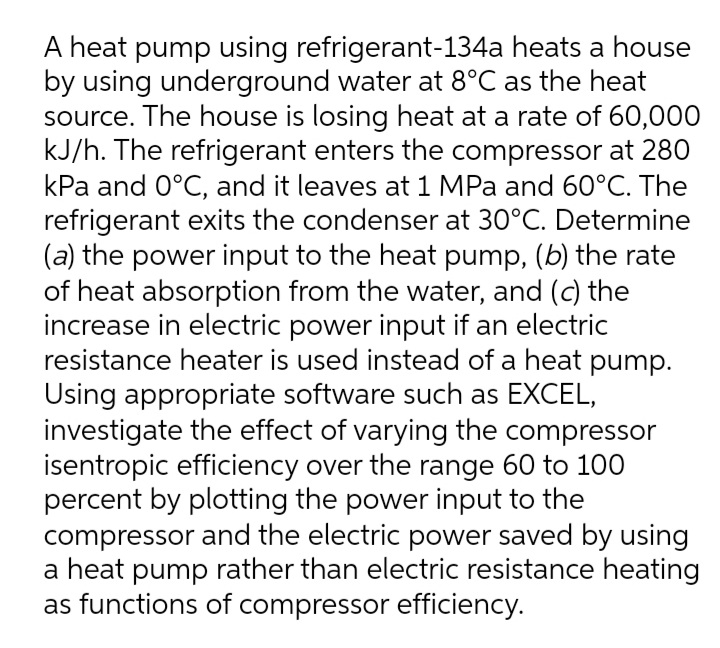A heat pump using refrigerant-134a heats a house by using underground water at 8°C as the heat source. The house is losing heat at a rate of 60,000 kJ/h. The refrigerant enters the compressor at 280 kPa and 0°C, and it leaves at 1 MPa and 60°C. The refrigerant exits the condenser at 30°C. Determine (a) the power input to the heat pump, (b) the rate of heat absorption from the water, and (c) the increase in electric power input if an electric resistance heater is used instead of a heat pump. Using appropriate software such as EXCEL, investigate the effect of varying the compressor isentropic efficiency over the range 60 to 100 percent by plotting the power input to the compressor and the electric power saved by using a heat pump rather than electric resistance heating as functions of compressor efficiency.
A heat pump using refrigerant-134a heats a house by using underground water at 8°C as the heat source. The house is losing heat at a rate of 60,000 kJ/h. The refrigerant enters the compressor at 280 kPa and 0°C, and it leaves at 1 MPa and 60°C. The refrigerant exits the condenser at 30°C. Determine (a) the power input to the heat pump, (b) the rate of heat absorption from the water, and (c) the increase in electric power input if an electric resistance heater is used instead of a heat pump. Using appropriate software such as EXCEL, investigate the effect of varying the compressor isentropic efficiency over the range 60 to 100 percent by plotting the power input to the compressor and the electric power saved by using a heat pump rather than electric resistance heating as functions of compressor efficiency.
Refrigeration and Air Conditioning Technology (MindTap Course List)
8th Edition
ISBN:9781305578296
Author:John Tomczyk, Eugene Silberstein, Bill Whitman, Bill Johnson
Publisher:John Tomczyk, Eugene Silberstein, Bill Whitman, Bill Johnson
Chapter28: Special Refrigeration Applications
Section: Chapter Questions
Problem 15RQ: Why is two-stage compression popular for extra-low-temperature refrigeration systems?
Related questions
Question

Transcribed Image Text:A heat pump using refrigerant-134a heats a house
by using underground water at 8°C as the heat
source. The house is losing heat at a rate of 60,000
kJ/h. The refrigerant enters the compressor at 280
kPa and 0°C, and it leaves at 1 MPa and 60°C. The
refrigerant exits the condenser at 30°C. Determine
(a) the power input to the heat pump, (b) the rate
of heat absorption from the water, and (c) the
increase in electric power input if an electric
resistance heater is used instead of a heat pump.
Using appropriate software such as EXCEL,
investigate the effect of varying the compressor
isentropic efficiency over the range 60 to 100
percent by plotting the power input to the
compressor and the electric power saved by using
a heat pump rather than electric resistance heating
as functions of compressor efficiency.
Expert Solution
This question has been solved!
Explore an expertly crafted, step-by-step solution for a thorough understanding of key concepts.
This is a popular solution!
Trending now
This is a popular solution!
Step by step
Solved in 2 steps with 1 images

Knowledge Booster
Learn more about
Need a deep-dive on the concept behind this application? Look no further. Learn more about this topic, mechanical-engineering and related others by exploring similar questions and additional content below.Recommended textbooks for you

Refrigeration and Air Conditioning Technology (Mi…
Mechanical Engineering
ISBN:
9781305578296
Author:
John Tomczyk, Eugene Silberstein, Bill Whitman, Bill Johnson
Publisher:
Cengage Learning

Refrigeration and Air Conditioning Technology (Mi…
Mechanical Engineering
ISBN:
9781305578296
Author:
John Tomczyk, Eugene Silberstein, Bill Whitman, Bill Johnson
Publisher:
Cengage Learning